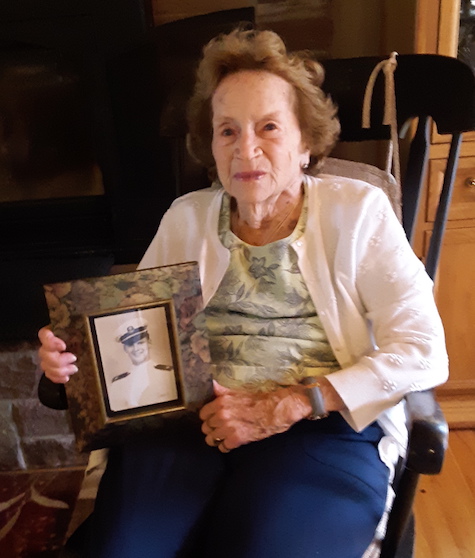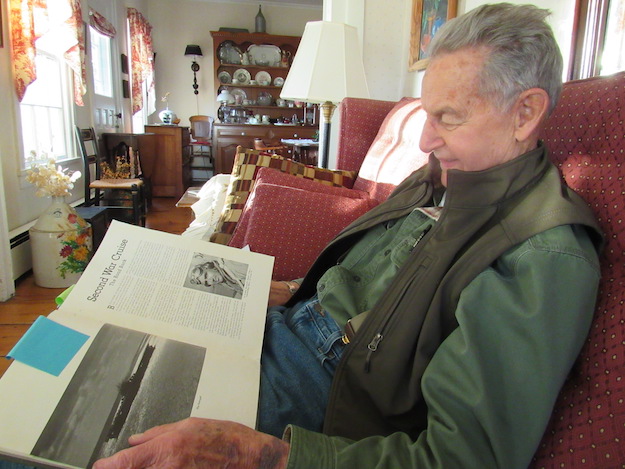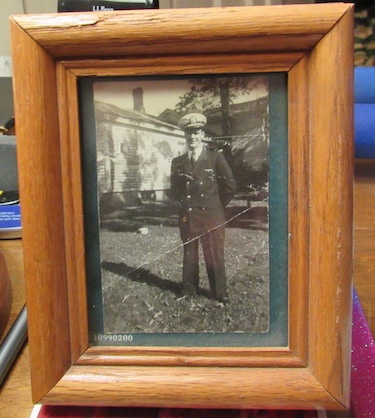Family reflects on ‘unsung hero’ who was torpedo bomber in World War II
Bob Nesbitt earned the Navy Cross for extraordinary heroism

Photos by Ginny Kropf: Beth Nesbitt of Pine Hill, widow of the late Bob Nesbitt, holds a picture of her husband in his dress white Navy uniform. Bob died of cancer at the age of 66.
BARRE – Many Veterans’ and Memorial Day holidays have come and gone since World War II ended, but never has Bob Nesbitt been given the recognition he deserves, according to his cousin Charlie Nesbitt of Albion.
Charlie is a war hero, having been presented with the Distinguished Flying Cross for his actions as a helicopter pilot in Vietnam. Still, he thinks Bob should be given credit for his actions as a torpedo bomber pilot for the Navy in the Pacific during World War II.
Bob’s dad and Charlie’s grandfather were brothers. In Charlie’s eyes, Bob is an unsung hero.
Bob was born in 1919. He met, Beth, who was J. Howard Pratt’s daughter, at a 4-H function. By the time the war started, they were dating. She wrote to him regularly while he was serving with the Navy. They were married on Dec. 7, 1946 and had seven children. Beth will celebrate her 101st birthday on Aug. 7.
Bob grew up working on the family farm with his younger brothers Pete and Lynn Nesbitt.
Pete still lives on the family farm on Pine Hill Road, next door to Beth, who lives there with her daughter and son-in-law, Nancy and Larry Eastlack. Pete said flying was always in their blood. Bob learned to fly in a Piper Cub on Pete Dragan’s farm south of Albion.
With the late Gene Haines, they started Pine Hill Airport. Pete said Hank Keeler of Albion and Chet Zelazny of Shelby were partners in the airport for a while.
Larry said he heard Bob tell he had to drive back and forth to Niagara Falls Air Force Base when he was in the Reserves after the war, and he figured if he had a landing strip, he could fly back and forth. Pete remembers when he and Haines were out with tractors and a cultipacker packing down the snow so Bob could land. Larry also said he had been told stories of how Bob would buzz the house when he returned home, and that was Beth’s signal to drive next door to the airport and park at the end of the runway with her lights on, so Bob knew where to land.
Bob and Pete were both Navy pilots, Bob enlisting in the Army Air Corps in the summer of 1942. Pete joined 12 years later, serving in peace time from 1954 to 1958.
“The places Bob bombed into submission during World War II, I visited 12 years later as a tourist,” Pete said.
Pete said his brother was very mechanical and started as a Naval Aviation Cadet in Meadville, Pa. He did his pre-flight training at the University of North Carolina at Chapel Hill, where he held the record on the obstacle course.
Bob never talked much about the war, Pete said.
Bob was 22 when he enlisted, which was considered “old” for a pilot at the time, Pete said.
“The guys in his group called him ‘Daddy,’” Pete said.

Pete Nesbitt of Pine Hill looks at pictures and a story about his brother Bob in a squadron yearbook about Navy pilots in World War II. Bob was a torpedo bomber pilot in the Pacific.
Bob flew TBM’s off the carrier Hancock.
Bob talked about his wingman who knocked on his door one night and said, “I can’t sleep. I know one of those shells has my name on it.”
“Bob said he saw 20-year-old guys’ hair turn white in two months,” Pete said.
Another member of his squadron was actor Richard Boone.
Bob’s squadron had orders to go to Tokyo on a bombing mission. Bob was the last one to be launched off the ship and couldn’t catch up with his group. But he headed to Tokyo and joined the flight of TBMs along the coast. They were in a thin broken layer of overcast, and when they broke out, they were lined up perfectly with a Jap battleship in the harbor.
Bob dove in and dropped four 500-pound bombs on the ship, sinking it. His gunner said the bombs bounced before they exploded.

This picture of Bob Nesbitt in his Navy uniform during World War II sits on his brother Pete’s end table in his Pine Hill home. A torpedo bomber pilot in the Pacific, Bob earned two Navy Crosses for his heroism during the war.
Bob was infamous for his tactics, especially flying so low over the water. It may have been what kept him safe, as Charlie recalled being a torpedo bomber pilot was considered very dangerous. At the time Bob enlisted, 135 torpedo bomber pilots had been lost in combat. Bob used to skim a few feet off the water and he would be so low, the Japanese gunners on the deck of a ship would shoot right over him.
Bob used to brag about doing barrel rolls around the other planes landing in the formation. All in all, he spent one year in combat.
Larry talked about how Bob said he wanted to be the first American soldier to set down on Japanese soil. He was on a bombing run and saw a bombed out airport, but it was still occupied. Bob, however, dropped down and touched the runway and took off, all the while being shot at by the Japanese
“True or not, that was Bob’s story,” Larry said. “Bob had no reason to exaggerate.”
Larry said he has always looked at the aspect of what women did during the war. While Bob was bombing ships in the Pacific, Beth was working at a gun-making factory in Buffalo – seven days a week, 12 hours a day.
“Her job was to make sure the gun sights were accurate,” Larry said. “Bob could have been looking through gun sights that his wife checked out in Buffalo.”
Bob always said the reason he flew so low on a mission is because he wanted to be sure his bomb landed right where he wanted it. Larry said Bob was credited with destroying a refueler, and his bombs hit directly on the fuel tanks. Bob later said the blast nearly downed his plane.
Bob would be awarded two Navy Crosses for his heroism in battle. He was nominated for a third, but told the Navy to give it to someone else. The Navy Cross is the second-highest award given to sailors or marines, just a level below the Congressional Medal of Honor. The Navy Cross is given to soldiers who show extraordinary heroism in combat with an armed enemy force.
Larry told the story of how, years after the war, Pete and Bob went to a military banquet in Philadelphia, where the speaker was an ace pilot from the Rochester area. During his speech, the pilot said he was up there talking about his actions as a pilot, when there was another ace who lived in Western New York who should be mentioned. He asked if anybody there had ever heard of Bob Nesbitt.
One of Larry’s fondest memories is the time in the early 1980s when Bob flew him and Nancy to Philadelphia to visit a Navy yard. An aircraft carrier there was waiting to be dismantled and Bob went to the guard shack and asked what the name of the ship was. It was the Hancock.
“I thought Bob was going to go into shock,” Larry said. “The guard wasn’t supposed to, but he made an exception and took us on a tour of the ship. Bob got to make one last tour of the ship he served on before it was reduced to scrap iron.”









































































